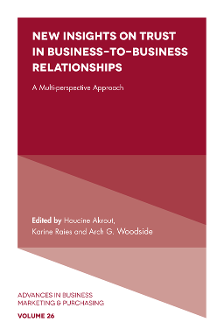
Index
New Insights on Trust in Business-to-Business Relationships
ISBN: 978-1-83867-063-4, eISBN: 978-1-83867-062-7
ISSN: 1069-0964
Publication date: 15 August 2019
Citation
(2019), "Index", New Insights on Trust in Business-to-Business Relationships (Advances in Business Marketing and Purchasing, Vol. 26), Emerald Publishing Limited, Leeds, pp. 159-164. https://doi.org/10.1108/S1069-096420190000026001
Publisher
:Emerald Publishing Limited
Copyright © 2019 Emerald Publishing Limited
INDEX
- Prelims
- Trust in Buyer–Supplier Relationships: Evidence from Advanced, Emerging, and Developing Markets
- A Global Examination of Cognitive Trust in Business-to-Business Relationships
- A Model to Enhance the Perceived Trustworthiness of Small and Medium Enterprises Selling Natural Essential Oils through e-Marketplaces
- Enhancing Electronic Markets for Industrial Services by Trust Features
- Interpersonal and Inter-organizational Trust in High-involvement Customer–Supplier Relationships: Antecedents, Consequences, and Moderators
- Trust in Relationships with Agri-food Distribution
- Window to New Research Approaches: How Using Simon’s Scissors Cuts Perplexity in Strategy Theory, Research, and Practice
- Index